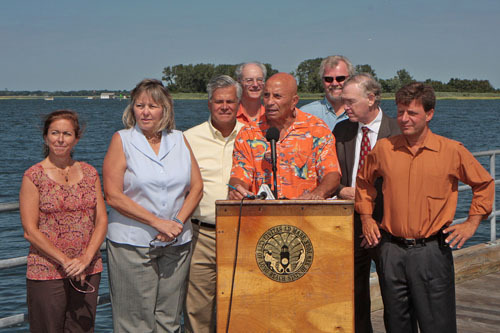Study to examine pollution in Western Bays
By Anthony Rifilato
“The bay is very sick,” said Long Beach resident Bernie Klepper, 71, as he fished with his friend Matthew Rosentraub on the Magnolia Pier. “The water is not clear like it used to be. Sometimes you can see the sludge from the bottom.”
Rosentraub echoed his friend, as he cast a line out on the western side of the pier. Years ago, these men were reeling in large fish. Now, they said, they’re lucky if they hook a four-to-six-inch catch.
“It has deteriorated considerably,” said Rosentraub, who has fished here since the 1960s. “There used to be quite a bit of fish — flounder, blowfish, fluke — now there are days when you come down and the water is brown.”
Now, after years of efforts to address the bay’s environmental issues, there is new hope that the fish and the waterways could flourish once again, after state lawmakers announced that they secured nearly $600,000 in state funding for a pollution study that is aimed at determining and improving the water quality of the Western Bays.
Assemblyman Harvey Weisenberg (D-Long Beach) and Senator Dean Skelos (R-Rockville Centre) announced the funding at a press conference on the Magnolia Pier on Aug. 13, in what they said was the culmination of a seven-year effort that involved Nassau County legislators, city officials and environmental organizations such as Operation SPLASH working together to find ways to address the bay’s deteriorating condition.
Between East Rockaway and Long Beach, the Western Bay area is home to four sewage treatment plants and one power plant, which officials said discharge 64.5 million gallons of wastewater daily into the bay. Although officials said that these facilities have been hit with several violations over the years, they said that preliminary testing indicates that the level of pollutants is well beyond safe levels.
Weisenberg, who used to go clamming in the bay as a boy, said that the current levels of pollution are potentially hazardous. He said the funding will lead to the next step in “definitively addressing and correcting a situation that continues to denigrate one of Long Island’s most precious natural resources.”
“I used to swim across the bay … and then one day I saw this orange water coming into the bay and I said, ‘where is this coming from?’” he said. “Senator Skelos and I, working together in Albany, were able to get $600,000 for research … to find what’s in our bay? What’s causing it? What’s coming out of the water treatment plant, what’s coming out of LIPA? We’re here to find out and get answers.”
The study will be conducted by researchers at Stony Brook University. The money, secured from the state’s Environmental Protection Fund’s Open Space Account, will be used to fund the research, known as the Total Maximum Daily Load Study of the Western Bay Quality Monitoring System. A Total Maximum Daily Load is a calculation of the maximum amount of a pollutant that a water body can receive and still safely meet water quality standards, according to the Environmental Protection Agency.
“We worked together for seven years, and we believe this study represents a new beginning for a cleaner, healthier Western Bays,” said Adrienne Esposito, executive director of the Citizens Campaign for the Environment. “The study is needed to assess why the water body is degrading, and determine ways to fix it. This is going to be the most comprehensive study for this water body, and we believe that this is a new beginning for the bays.”
The study is expected to take two-years, with researchers saying that it will include examining historic data; examining different contaminants and sediments, runoff, and water depth. Ultimately, the goal is to pinpoint exactly what is being released into the bay and ways to make it cleaner.
Larry Swanson, the lead investigator for the study and a professor at Stony Brook’s School of Marine and Atmospheric Studies, said he hopes the study will determine ways to not only pinpoint what’s causing the bay’s deterioration and ways to remediate it, but to also spur the sewage and power facilities to adopt “forward thinking” ways to stave off pollutants. Weisenberg said that he’s hopeful that the results of the study will lead to federal funds and the assistance of the Department of Environmental Conservation.
Nassau County Legislator Denise Ford (R-Long Beach) said that for years, local officials and organizations have fought for the study and funding, a bipartisan effort that had finally led to funding being secured last year, only to be squashed when Governor David Paterson put a freeze on all state spending.
“All of the groups had a stake in this and worked tirelessly to make sure this study gets done,” Ford said.
Now, Skelos and others said that the study will determine what materials are being released into the bays and the impact it‘s having on water quality, adding that once the research is released, federal funding can be pursued to “ensure safe water quality.”
“This grant to Stony Brook will afford them the opportunity to do research to find out how we can restore the bays to the way they were 30 years ago,” Skelos said.
Long Beach City Councilman Mike Fagen said that while marine life is flourishing on the ocean side of Long Beach, the same cannot be said of the bays.
“Now we can decide once and for all what needs to be done with the bay,” Fagen said.
The announcement has some locals hopeful that the bay will thrive as it did in the past.
“Maybe with the money they’re getting,” Rosentraub said, “they can find out what’s causing [the bay’s] decline.”
Comments about this story? Arifilato@liherald.com or (516) 569-4000 ext. 213.






